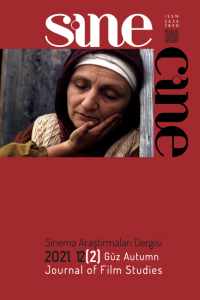Türkiye’den Filmlerde Geçmişi Belgelemek için Mektup Formunun Kullanımı
Bu makale, travmatik geçmişle ilgilenen, Türkiye’den konvansiyonel olmayan filmlerde kullanılan mektup formuna odaklanmaktadır. Mektup formuna biçimsel yaklaşım Hamid Naficy’nin (2001) aksanlı stil tanımına dayanmaktadır. Seçilen filmlerdeki mektup formları mecra özelliklerine göre kategorilendirilmiş, biçim ve anlatı öğesi olarak incelenmiştir. Mektup formu geçmişle ilişki kurmada temel strateji olarak tartışılmış ve geçmişi belgeleme işlevi Marianne Hirsh’ün (2008) hafıza sonrası kavramı ile anlamlandırılmıştır.
Anahtar Kelimeler:
mektup formu, hafıza sonrası, Türkiye'de sinema, arşiv, hakikat
The Use of Epistolarity for Documenting the Past in Films From Turkey
This article focuses on the epistolary form in unconventional Turkish films preoccupied with a traumatic past. The formal approach to epistolarity depends on Hamid Naficy’s (2001) description of accented style. The epistles in selected films are categorized according to medium and are analyzed as formal and as narrative elements. Epistolarity is discussed as one of the prominent strategies for engaging with the past, and its function as documentation of the past is understood in terms of Marianne Hirsh’s (2008) conceptualization of postmemory.
Keywords:
epistolarity, postmemory, Turkish cinema, archive, truth,
___
- Alper, Ö. (Director/ Writer). (2011). Gelecek Uzun Sürer [Motion picture]. Turkey, Germany, France: Nar Film, Arizona Films, Una Film.
- Altman, J. G. (1982). Epistolarity: Approaches to a form. Ohio: Ohio State University Press.
- Assman, J. (2008). Communicative and Cultural Memory In Erll, A. and Nünning, A. (Eds.), Cultural Memory Studies: An International and Interdisciplinary Handbook. (109-118). Berlin, New York: Walter de Gruyter.
- Baronian, M. A. (2010). Image, displacement, prosthesis: reflections on making visual archives of the Armenian genocide. Photographies, 3(2), 205-223.
- Barthes, R. (1981). Camera Lucida. New York: Hill and Wang.
- Bazin, A (1960). The Ontology of the Photographic Image. Film Quarterly, Vol. 13, No. 4. (Summer, 1960), pp. 4-9.
- Bozkurt, H., & Kaya, Ö. (2014). "Holding Up the Photograph": Experiences of the Women Whose Husbands Were Forcibly Disappeared. İstanbul: Hakikat Adalet Hafıza Merkezi.
- Chion, M. (1994). Audio-vision: sound on screen. New York: Columbia University Press.
- Çiçek, Ö. (2016). The Fictive Archive: Kurdish Filmmaking in Turkey. In Koçer, S. & Candan, C. (eds.) Kurdish Documentary Cinema in Turkey: The Politics and Aesthetics of Identity and Resistance (pp 70-85). Newcastle upon Tyne: Cambridge Scholars Publishing.
- Çiftçi, A. (2016). Kurdish Films in Turkey: Claims of Truth-Telling and Convergences between Fiction and Non-Fiction. In Koçem, S. & Candan, C. (Eds.), Kurdish Documentary Cinema in Turkey (pp. 86-111). Newcastle upon Tyne: Cambridge Scholars Publishing.
- Derrida, J. (1995). Archive Fever: A Freudian Impression. Diacritics, 25(2), 9-63.
- Eng, D., & Kazanjian, D. (2003). Mourning Remains. In D. Eng & D. Kazanjian (Eds.), Loss the politics of mourning. Berkeley: University of California Press.
- Epistle (n.d.). Retrieved August 12, 2019, https://www.merriamwebster.com/dictionary/epistle.
- Eskiköy, O. & Doğan, Z. (Directors). (2012). Dengê Bavê Min [Motion picture]. Turkey, Germany, France: Perişan Film.
- Gordon, A. (2008). Ghostly matters haunting and the sociological imagination (New University of Minnesota Press ed.). Minneapolis: University of Minnesota Press.
- Hirsch, J. (2004). Afterimage: film, trauma and the Holocaust. Philadelphia: Temple University Press.
- Hirsch, M. (1997). Family frames: Photography, narrative, and postmemory. Cambridge, Massachusetts: Harvard University Press.
- Hirsch, M. (2008). The Generation of Postmemory: Writing and Visual Culture After the Holocaust. Poetics Today, 29 (1), 103-128.
- Kristeva, J. (1989). The Black Sun: Depression and Melancholia. New York: Columbia University Press.
- Kuhn, A. (2007). Photography and cultural memory: a methodological exploration. Visual Studies, Vol. 22, No. 3, December 2007, pp. 283-292.
- Marks, L. U. (2000). The Skin of the Film Intercultural Cinema, Embodiment and the Senses. Durham, North Carolina: Duke University Press.
- Mintaş, E. (Director/ Writer). (2014). Klama Dayîka Min [Motion picture]. Turkey, Germany, France: Mitos Film, Arizona Films, Mintaş Film.
- Naficy, H. (2001). An Accented cinema: Exilic and diasporic filmmaking. Princeton: Princeton University Press.
- Öz, K. (Director/ Writer). (2001). Fotoğraf [Motion picture]. Turkey: Mezopotamya Kültür Merkezi.
- Özyürek, E. (2007). Introduction. In Özyürek (Eds.), The politics of public memory in Turkey. Syracuse, New York: Syracuse University Press.
- Radstone, S. (2000a). Working with Memory. In Radstone S. (Eds.), Memory and Methodology. (79-110). London: Bloomsbury Academic.
- Radstone, S. (2000b). Screening Trauma: Forrest Gump, Film and Memory. In Radstone S. (Eds.), Memory and Methodology. (79-110). London: Bloomsbury Academic.
- Sirman, N. (2006). Constituting public emotions through memory: interviewing witnesses. New Perspectives on Turkey, 34, 31-46.
- Sontag, S. (1977). On Photography. New York: Penguin Books.
- Suner, A. (2010). New Turkish cinema: Belonging, identity, and memory. London: I.B. Tauris.
- Turim, M. (1989). Flashbacks in film: memory & history. New York: Routledge.
- Ustaoğlu, Y. (Director/ Writer). (1999). Güneşe Yolculuk [Motion picture]. Turkey, Germany, The Netherlands: İstisnai Filmler, Medias Res Berlin, The Film Company Amsterdam.
- Ustaoğlu, Y. (Director/ Writer). (2003). Bulutları Beklerken [Motion picture]. Turkey, Greece, France, Germany: Silkroad, Flying Moon Filmproduktion, Ideefixe Films.
- Walker, J. (2005). Trauma cinema: Documenting incest and the Holocaust. Berkeley: University of California Press.
- ISSN: 2636-784X
- Yayın Aralığı: Yıllık
- Başlangıç: 2010
- Yayıncı: Semire Ruken Öztürk
Sayıdaki Diğer Makaleler
The Lobster Filmini Samuel Beckett’ın İki Metniyle Birlikte Okumak
Anımsama, Unutuş ve Bellek: Andrey Tarkovsky’nin Nostalghıa’sı Üzerine Bir İnceleme
ANIMSAMA, UNUTUŞ VE BELLEK: ANDREY TARKOVSKY’NİN NOSTALGHIA’SI ÜZERİNE BİR İNCELEME
AHLAT AĞACI: TAŞRADA DÖNÜŞÜMÜ İZLEMEK
Ahlat Ağacı: Taşrada Dönüşümü İzlemek
Kelebekler Filminin “Travma” ve “Yas” Bağlamında İncelenmesi
Browning’in ve Coppola’nın Dracula Uyarlamalarında İmge Aralarını Okumak
The Watermelon Woman ve Brother to Brother Filmlerinde Siyah Queer Deneyimi ve Yenilenme Olgusu
